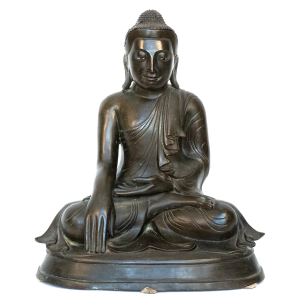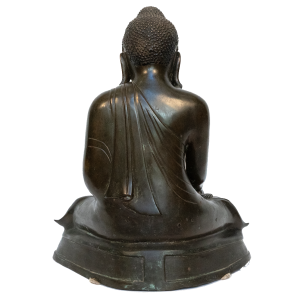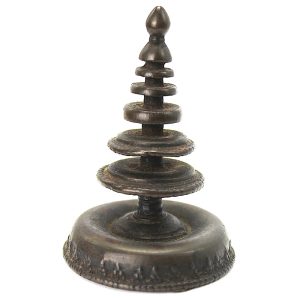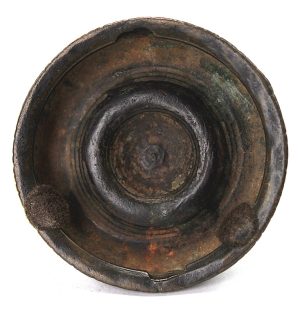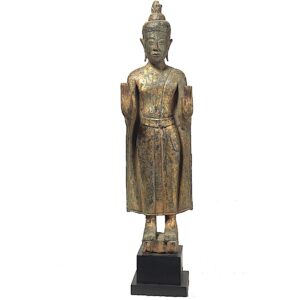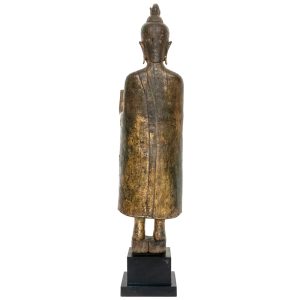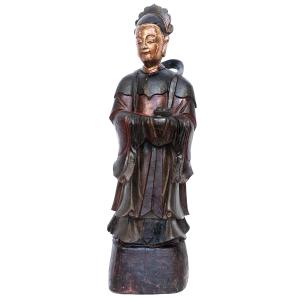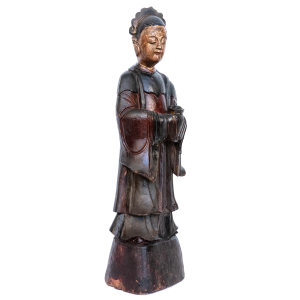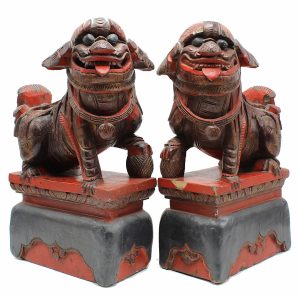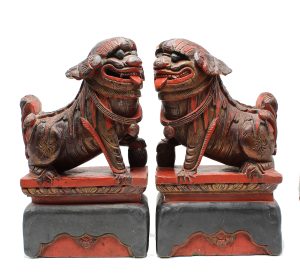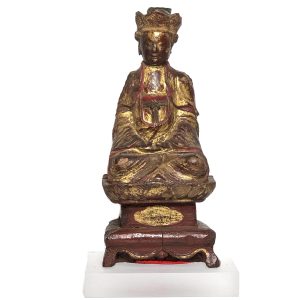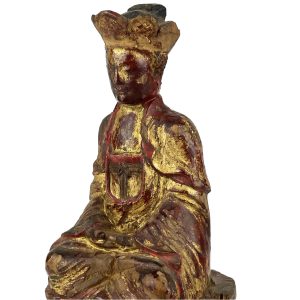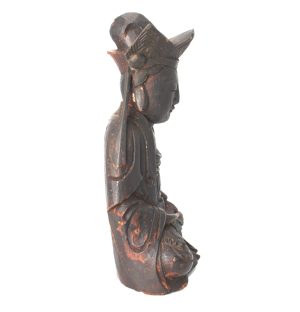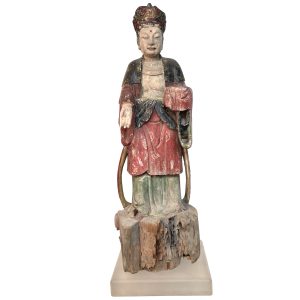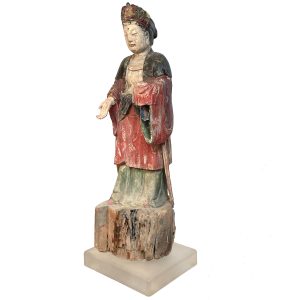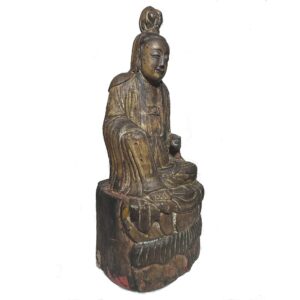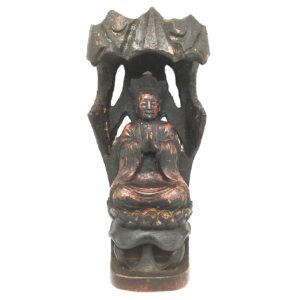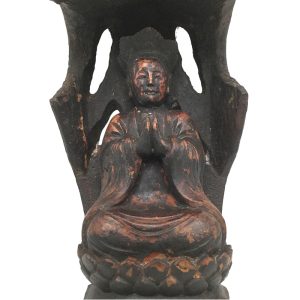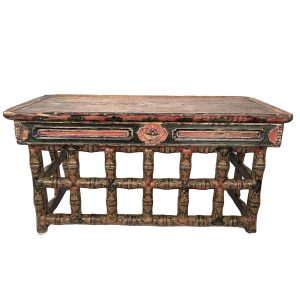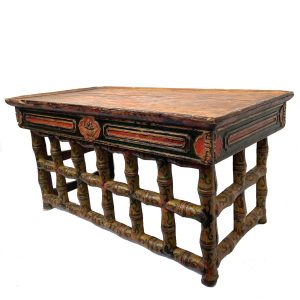Showing 1–12 of 40 results
-
Sale!


$3,800.00 Original price was: $3,800.00.$2,900.00Current price is: $2,900.00.
H: 22” W: 17” D: 11” | CALL 213-568-3030 or email us at [email protected] FOR SHIPPING
Finely modeled vintage Mandalay style Burmese bronze Buddha in Earth Witnessing mudra made by lost wax process is a one-of-a-kind exquisite work of art. Soft youthfully sweet smiling face with almond-shaped eyes are inlaid with glass.
-
Sale!


$425.00 Original price was: $425.00.$295.00Current price is: $295.00.
H: 3.5″ Dia 2.5″ | FREE SHIPPING WITHIN CONTINENTAL U.S.
Hand-made metal Nepalese 7-level stupa/pagoda with decorative details around the base and round eaves with scalloped edges used for personal worship.
-
Sale!


$1,475.00 Original price was: $1,475.00.$1,195.00Current price is: $1,195.00.
H: 20″ W: 3.75 D: 3.75″ | CALL 213-568-3030 OR EMAIL [email protected] FOR SHIPPING.
Rare antique, wood Theravada Lao Buddha in abhaya mudra symbolizing reassurance, divine protection, and dispelling fear. Gilt paint reflects his golden skin.
-
Sale!


$2,400.00 Original price was: $2,400.00.$1,950.00Current price is: $1,950.00.
H: 25″ W: 7.5″ D: 6″ | CALL 213-568-3030 OR EMAIL [email protected] FOR SHIPPING.
Graceful celestial attendant carrying offerings with ribbon winding around her with a modest and serene demeanor honoring the deity she attends.
-
Sale!


$995.00 Original price was: $995.00.$695.00Current price is: $695.00.
H: 12″ D: 7″ D: 7.75″ | FOR SHIPPING INFORMATION CONTACT US AT 213-568-3030
This very fine pair of antique carved males fu lions represents the dual nature of these mythical animals: as protective images they are powerful and fierce, as Buddhist images they are whimsical with smiling faces, dangling tongues, hanging ears and bushy tails. They are extremely well carved with harnesses and bells around their necks, detailed manes and tails on high intricately decorated bases to signal their importance. Perfect for enhancing feng shui in a home or office, large finely decorative wood pairs like this are extremely hard to find.
-
Sale!


$535.00 Original price was: $535.00.$450.00Current price is: $450.00.
Ht: 10.5” W: 5.5” D: 4” | FREE SHIPPING in continental u.s.
Guanyin in lacquer and gilt sits on a lotus throne in meditation atop a decorative footed stand, regally depicted with elegantly draped robes and a 5-lobe crown with a cross hatch design. Consecrated for home altar use.
-
Sale!


$395.00 Original price was: $395.00.$325.00Current price is: $325.00.
H: 8.25″ W: 4.5″ D: 3″ | FREE SHIPPING within continental u.s.
Delicately carved antique Guanyin in meditation, tall 3-lobed crown with flaring triangles and crosshatches. high forehead and oversized head focuses viewer on beautifully formed, quiet and calm face as model of inner serenity
-
Sale!


$1,495.00 Original price was: $1,495.00.$1,330.00Current price is: $1,330.00.
H: 33.5″ W: 33″ D: 10″ | call 213-568-3030 or email [email protected] for shipping
In the Pure Land Buddhist tradition this vibrant provincial Guanyin wears a high crown centered with Amitabha Buddha. Far from imperial influences, this charming carving is a unique eclectic folk art blend of Buddhism, Taoism and Popular Religion. traditions.
-
Sale!


$885.00 Original price was: $885.00.$695.00Current price is: $695.00.
H: 13.75″ W: 6″ D: 4.8″ | FREE SHIPPING WITHIN CONTINENTAL U.S.
White Hooded provincial Guanyin in lalitsana depicted as humble with a plain hood, gentle smile, holding a scroll symbolizing the Buddhist sutras in which she is mentioned including the Lotus Sutra Chapter 25.
-
Sale!


$450.00 Original price was: $450.00.$325.00Current price is: $325.00.
H: 11.75″ W: 5.25″ D: 4.75 ” | Free shipping within continental us
Provincial Nanhai Guanyin palms at heart in anjali mudra, a mudra of offering rarely used for Nanhai Guanyin. On lotus throne at Tidal Cave on Putuo under a craggy rock outcrop with pierced openwork.
-
Sale!


$650.00 Original price was: $650.00.$395.00Current price is: $395.00.
H: 7.75” W: 3.5″ D: 3.5″ | FREE SHIPPING within continental U.S.
Rare and charming carved attendant pair to flank deities on circular pedestals presenting boxed offerings with ribbons as wish for longevity.
-
Sale!


$750.00 Original price was: $750.00.$550.00Current price is: $550.00.
Ht: 13.75” W: 26.25” D: 13.125” | FOR SHIPPING INFORMATION CAL 213-568-3030 OR EMAIL [email protected]
One of a pair of Tibetan antique folding traveling prayer/study table for monks or nomadic families to lay out sutras (scriptures), scrolls, books, other study materials. Decorated with painted florals and fruit offering bowl symbolizing flowering of enlightenment and opening of the heart.
End of content
End of content

